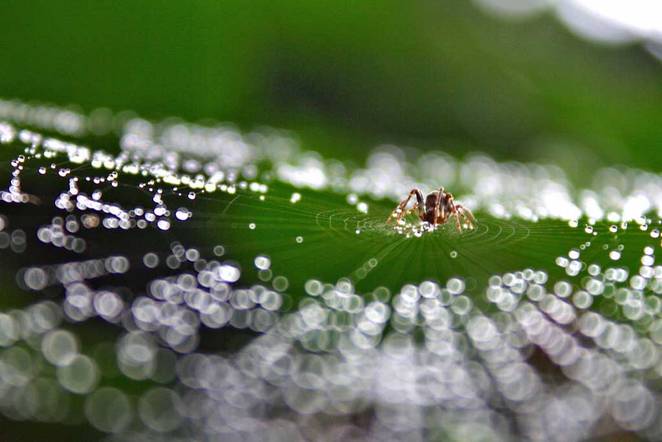Source: treehugger.com
Published: July 11, 2017

CC BY-SA 2.0 followtheseinstructions
A team of architects and chemists put their minds together on how to mimic spider silk. They came up with a double win.
They developed a fiber “spun” from a material called hydrogel, that is 98% water. The process developed at the University of Cambridge for making the “super stretchy, strong and sustainable” fiber imitating spider silk could make other textile manufacturing greener too.
Hydrogel consists of about 2% cellulose and silica (both natural materials) suspended in water with some molecules that are shaped like tiny bracelets, called Cucurbiturils(from the word cucurbita which is Latin for gourd, because of their hollow, rounded shape). These chemicals, described as “barrel-shaped molecular ‘handcuffs’” by the team at Cambridge, hold the cellulose and silica together, allowing long, extremely thin fibers to be pulled from the gel.
The water evaporates shortly after the fibers are drawn out of the hydrogel, leaving behind a silken strand that is stronger than cellulose-based viscose, artificial silk, and even some natural fibers such as animal hair. The strings also work like bungee cords, in some cases having a property of energy absorption called “damping capacity” that exceeds natural silks.
Manufacture of most synthetic fibers requires high energy inputs and uses hazardous solvents. Other synthetic fibers pose a growing ecological issue by polluting the seas with microfibers, sometimes called the “smog of the sea.”
But this new fiber is made at room temperature, which means low energy. And the hydrogel is just a watery bath, so the process avoids the toxic solvents.
The process developed to make this new fiber may teach traditional manufacturers how they can improve their processes – viscose (aka rayon) is itself a cellulose-based fiber. Then in addition to being the “made from bamboo” fiber, so called when the source of the cellulose is bamboo, the fabric could boast a sustainable and less hazardous manufacturing process.
The cucurbiturils are a sort of wonder material trending in chemical labs across the globe, where their unique properties could help in making nano-machines, detecting low levels of toxins, treating wastewaters, and more. They are themselves made up of only organic chemicals, so although more study of these unique compounds is merited, the risk that they will pose unsuspected new hazards compared to existing fiber options seems low.
It is an exciting development, especially for anyone interested in sustainable fashion.
For those into curcurbitil chemistry, read the paper on this newest development in the Proceedings of the National Academy of Sciences: Bioinspired supramolecular fibers drawn from a multiphase self-assembled hydrogel., 2017; 201705380 DOI: 10.1073/pnas.1705380114
